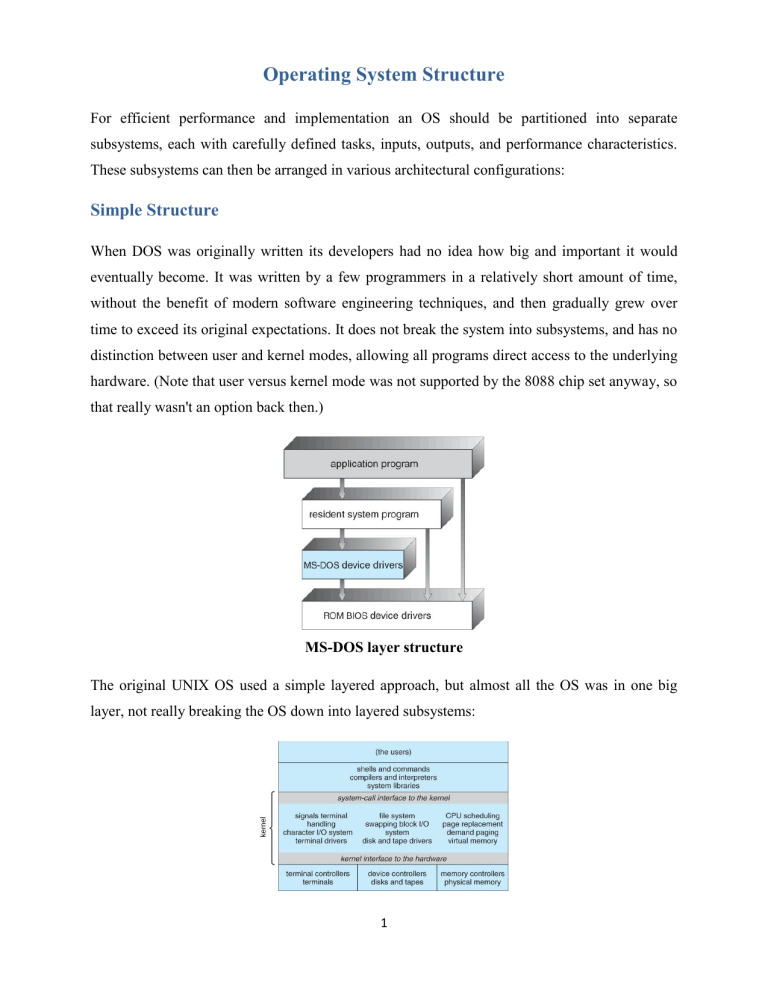
Operating System Structure For efficient performance and implementation an OS should be partitioned into separate subsystems, each with carefully defined tasks, inputs, outputs, and performance characteristics. These subsystems can then be arranged in various architectural configurations: Simple Structure When DOS was originally written its developers had no idea how big and important it would eventually become. It was written by a few programmers in a relatively short amount of time, without the benefit of modern software engineering techniques, and then gradually grew over time to exceed its original expectations. It does not break the system into subsystems, and has no distinction between user and kernel modes, allowing all programs direct access to the underlying hardware. (Note that user versus kernel mode was not supported by the 8088 chip set anyway, so that really wasn't an option back then.) MS-DOS layer structure The original UNIX OS used a simple layered approach, but almost all the OS was in one big layer, not really breaking the OS down into layered subsystems: 1 Traditional UNIX system structure Layered Approach Another approach is to break the OS into a number of smaller layers, each of which rests on the layer below it, and relies solely on the services provided by the next lower layer. This approach allows each layer to be developed and debugged independently, with the assumption that all lower layers have already been debugged and are trusted to deliver proper services. The problem is deciding what order in which to place the layers, as no layer can call upon the services of any higher layer, and so many chicken-and-egg situations may arise. Layered approaches can also be less efficient, as a request for service from a higher layer has to filter through all lower layers before it reaches the HW, possibly with significant processing at each step. A layered operating system Microkernels The basic idea behind micro kernels is to remove all non-essential services from the kernel, and implement them as system applications instead, thereby making the kernel as small and efficient as possible. Most microkernels provide basic process and memory management, and message passing between other services, and not much more. 2 Security and protection can be enhanced, as most services are performed in user mode, not kernel mode. System expansion can also be easier, because it only involves adding more system applications, not rebuilding a new kernel. Mach was the first and most widely known microkernel, and now forms a major component of Mac OSX. Windows NT was originally microkernel, but suffered from performance problems relative to Windows 95. NT 4.0 improved performance by moving more services into the kernel, and now XP is back to being more monolithic. Another microkernel example is QNX, a real-time OS for embedded systems. Architecture of a typical microkernel Modules Modern OS development is object-oriented, with a relatively small core kernel and a set of modules which can be linked in dynamically. See for example the Solaris structure, as shown in Figure below. Modules are similar to layers in that each subsystem has clearly defined tasks and interfaces, but any module is free to contact any other module, eliminating the problems of going through multiple intermediary layers, as well as the chicken-and-egg problems. 3 The kernel is relatively small in this architecture, similar to microkernels, but the kernel does not have to implement message passing since modules are free to contact each other directly. Solaris loadable modules Hybrid Systems Most OSes today do not strictly adhere to one architecture, but are hybrids of several. Mac OS X The Max OSX architecture relies on the Mach microkernel for basic system management services, and the BSD kernel for additional services. Application services and dynamically loadable modules ( kernel extensions ) provide the rest of the OS functionality: The Mac OS X structure iOS 4 The iOS operating system was developed by Apple for iPhones and iPads. It runs with less memory and computing power needs than Max OS X, and supports touchscreen interface and graphics for small screens: Architecture of Apple's iOS. Android The Android OS was developed for Android smartphones and tablets by the Open Handset Alliance, primarily Google. Android is an open-source OS, as opposed to iOS, which has lead to its popularity. Android includes versions of Linux and a Java virtual machine both optimized for small platforms. Android apps are developed using a special Java-for-Android development environment. Architecture of Google's Android 5

